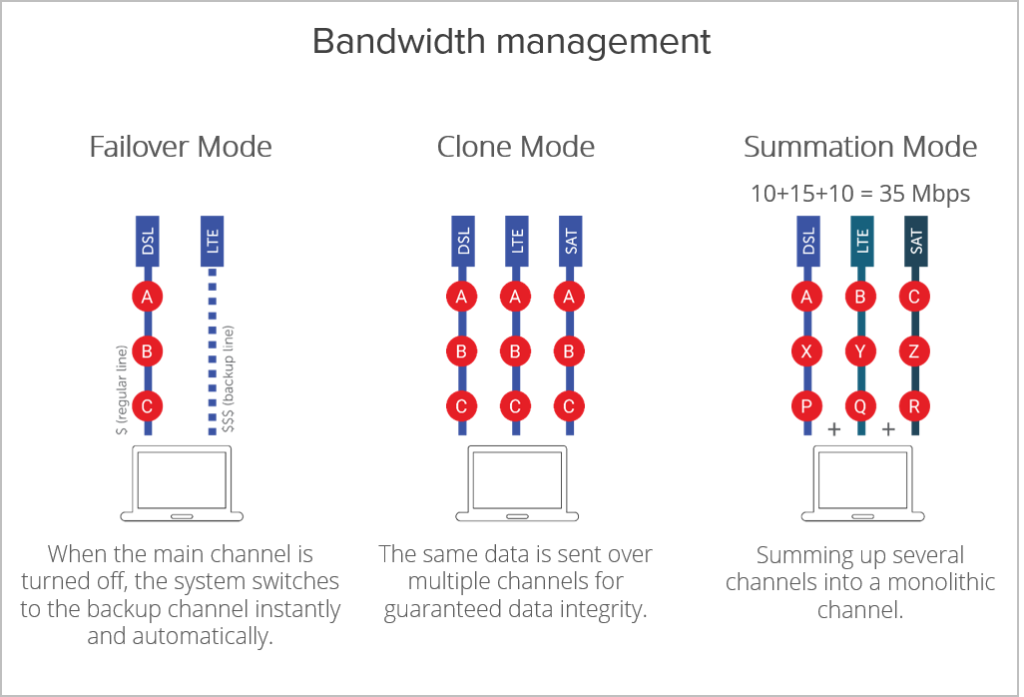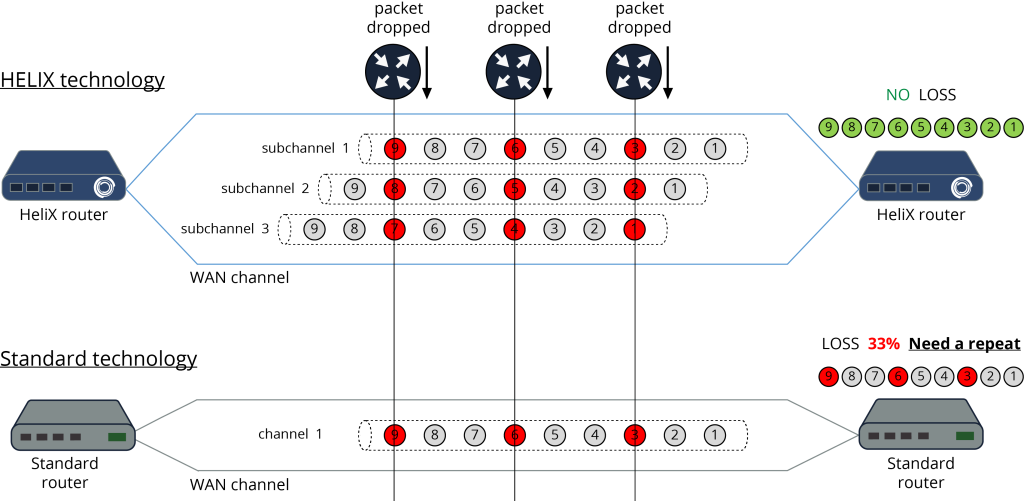Hot or cold data reservation

- Hot or cold redundancy with zero tap-changeover time in Failover Mode. For example: LTE channels can be hot redundant, which ensures no packet loss, even if the primary broadband connection is lost.
- Guaranteeing data integrity in Packet Cloning Mode by simultaneously transmitting the same packets over multiple channels.
- Increase aggregate throughput by using up to 255 different data channels (satellite, radio, fiber, broadband, DSL, 3G, LTE) in a unique Bandwidth Stack Mode.
Data Integrity

MSTNT preserves the sequence of data packets in the communication channels by eliminating loss, minimizing jitter, reducing delay, filtering duplicate packets, zero switchover time to redundant channels and no reorder packets.
Cloning mode
An example of how to use this feature:
In the normal case, the WAN allows traffic with different priority to be transmitted on different data links (each in its own way). Depending on the priority, the corresponding traffic is transmitted over a better or worse quality channel. But even the best channel does not allow to get rid of losses completely.

MSTNT makes it possible to reduce losses to almost zero when transmitting traffic with high priority.
There are two subchannels: mobile operator1 3G (MO1) and mobile operator2 3G (MO2). Each subchannel gives high jitter and packet loss of 10% For the MO1 subchannel, the MO2 partner is specified. When a payload packet is transmitted through the MO1 subchannel, a copy of the same packet is simultaneously transmitted through the MO2 subchannel. The packet has a unique sequence number so the receiving side can distinguish between two identical packets that come on different subchannels. Thus the receiving side accepts the first arriving packet and ignores all subsequent ones (if they arrived). This significantly reduces losses, since the probability of losing a packet while transmitting on two subchannels, each of which loses 10% of the data is ~ 1% and the jitter of such a subchannel will significantly decrease.

If we add a third subchannel to the scheme (mobile operator3), then the probability of data packet loss is already 0.1%!
That is, from three “bad” channels we gather one ideal! MO1 (main, partner MO2), MO2 (partner MO3).
Also, as it is clear from the described scheme at breakage of one of subchannels the loss of useful data will not happen since the same data, at the same time are transmitted and other two subchannels (partners). Using the described scheme, you can drive a car at a speed of 100 km per hour and the channel will be stable and will not depend on the coverage of the cellular network.
As long as there is coverage of at least one mobile operator communication will work.
Summation mode

The figure depicts the transfer of data using the MSTNT summation method in comparison to alternative methods.
In contrast to existing tunnel-forming systems, MSTNT provides the possibility of combining several sub-channels in the summation of bandwidth mode and in the reservation mode (whether in hot or cold setting).
The figure shows the data transfer using the MSTNT summation method, showing that the new MSTNT summation method can continue to function despite any connection failure in any subchannel, with the summation covering all available subchannels.
This summation of bandwidth of channels guarantees preservation of the packets sequence – packets leave the tunnel in the same order that they enter it. MNTP can transparently sum the transport channels and protect the data packets as they are transmitted even over an unsecured network, with automatic filtering of routing instructions and Ethernet traffic transmission with arbitrary 802.1q tags and a maximum transmission unit size up to 8,192 bytes.
Data integrity packet offset

Any subchannel (separately for tx and rx) can be defined as a Hot Backup slave.
In this case data packet transmitted through such subchannel will be cloned and simultaneously transmitted through Hot Backup slave subchannel.
The receiving side will process the first received packet. The other copies will be ignored.
This allows you to significantly improve the quality of communication: to eliminate losses, minimize the delay variation (Jitter).

